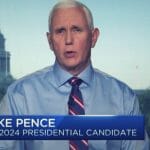Following is the unofficial transcript of a CNBC exclusive interview with Citadel Founder & CEO Ken Griffin on CNBC’s “Squawk on the Street” (M-F, 9AM-12PM ET) today, Thursday, September 14.
Citadel CEO: We Are Now At The Point Where We Will See The Impact Of Rates Hikes Start To Play Out
SARA EISEN: Hi, thank you Carl. And I am here with Ken Griffin, founder of Citadel. It’s good to see you here at Success Academy which I know you want to talk about. Thank you for joining us.
KEN GRIFFIN: It’s great to be here today.
EISEN: We’re going to talk about education and why success in a moment but but first big markets day for us, big IPO day. The folks were just talking about Arm. Do you do look at Arm which is the biggest debut in a couple of years as a sentiment barometer, how do you look at IPOs and what they signal about where we are in the market?
GRIFFIN: I mean, so clearly, the Arm transaction is a sentiment barometer. The very fact that deal’s coming to market today tells you there’s a perception that our capital markets are reopening for IPOs and I really hope this is a deal that goes off very well today. We need to see all of the VC backed companies of the last decade have that opportunity to go to our public markets and to raise capital so that the founders have an opportunity to continue to grow their businesses and grow our economy.
EISEN: It’s been a surprisingly good year for the markets and the economy which I think is reflected in the fact that they’re going public. Question Ken is what comes next?
GRIFFIN: So actually I would agree with you. It’s been a really good year for the market, particularly with the backdrop of higher real interest rates. So if you look at both the yield on the 10 Year bond, and more importantly, the real yield, for example, in the 5 Year TIPS bonds, we’ve seen again an increase in real rates and nominal rates, and yet the stock market’s been resilient. So that’s a that’s a really interesting year to see the resiliency of our stock market against this backdrop that would usually be very challenging for equities.
EISEN: Think it can continue?
GRIFFIN: I’m a bit anxious that this rally can continue. Obviously, one of the big drivers the rally has been the just frenzy over generative AI, which has powered many of the big tech stocks. I like to believe that this rally has legs. I’m a bit anxious. We’re we’re sort of in the 7th or 8th inning of this rally.
EISEN: Well part of it has been the soft landing story. Are you a buyer of that the fact that we just haven’t gone into recession despite 525 basis points of tightening?
GRIFFIN: So, it takes about a year to two years for an interest rate hike to work its way through the economy. It’s not instantaneous. We’re now at the point where we’re going to see the impact of these hikes really start to play out. We’re seeing the job market starting to weaken. There’s been there’s been a number of news stories in recent weeks about how companies are willing to pull back with what they’re paying for starting roles.
We’re seeing signs that consumers have had enough in terms of price increases, that they’re starting to walk away from products or trying to push through price increases. So there’s signs here that we’re heading very quickly into hopefully the soft landing, potentially more difficult scenario, moving into mid to late last year in terms of an actual recession.
EISEN: Sounds like that is what you’re expecting, a recession.
GRIFFIN: Look, my personal view is that the United States economy is enjoying a tremendous amount of unanticipated stimulus from Washington still. The federal deficit this year is going to total almost 6% of GDP. It is completely unsustainable. But it has been yet another shot of adrenaline to the economy that our fiscal large — continues to push the economy forward. But leaving an ever, ever bigger bill for future generations.
EISEN: Do you think, it also complicates the Fed’s job a little bit. We’re still getting these numbers. Inflation has come down a lot but looks to be sticky.
GRIFFIN: Well, I mean he’s in a no-win situation.
EISEN: Powell?
GRIFFIN: Powell is, right, because monetary tightening can only do so much to offset fiscal stimulus. And in some sense, it’s like he’s showing up at a fight with both of his hands tied behind his back because DC is just on a different agenda than he is. He’s trying to prudently slow the economy, bring inflation back down and really engineer the whole full soft landing. And at the same time, whether it’s the Inflation Reduction Act or other programs that have increased spending, we keep stimulating the economy out of DC.
EISEN: But do you think those, those pieces of legislation are a mistake? Inflation Reduction Act, Chips Act, aren’t those helpful for our future?
GRIFFIN: So, there are there are absolutely elements of this legislation that are important. So, for example, if we can successfully bring chip manufacturing back to the United States, that helps us maintain national security, both from a matter of national defense and economically against shifting geopolitical tides. So that’s a really important piece of legislation.
But if you look at the amount of spending that goes towards that part of the overall legislative agenda, it’s like a drop in the bucket. There’s been a tremendous amount of spending and a whole slew of different things that don’t have the same element of both being in an interest of national security economically and defense.
EISEN: So, you’re worried about all the fiscal spending. Do you think that that the market is starting to worry about that?
GRIFFIN: Absolutely. And let’s just take a step back. At the start of the year, people thought that the deficit was going to be roughly 3% of GDP and of note—
EISEN: It’s double that.
GRIFFIN: It’s double that, it’s six, almost six, where we have full employement in this country, things don’t get much better. And we still can’t keep our fiscal house in order. And now that the CBO is putting out their projections that for the next several years, we’re going to run deficits are of roughly 5%. The fixed income markets are getting nervous. It’s an unsustainable path.
EISEN: You think there’s gonna be an issue with demand for all the issuance?
GRIFFIN: Well, one of the questions is, is this rise in real yields that we’ve seen over the last few months really attributable to the Fed tightening or—
EISEN: Fiscal.
GRIFFIN: Is it fiscal. Is it the markets fearful about the magnitude of supply and to be clear, this, the possibility of credit risk. You know, we have the U.S. government downgraded by Fitch a few months ago.
EISEN: Do you think that was the right call?
GRIFFIN: If it wakes up our politicians in Washington, absolutely the right call.
EISEN: Not sure it’s doing that.
GRIFFIN: Well, it starts somewhere, right at some point. We’re talking about it today, right. In fact, you’re curious about this. This is the start of how we actually make policy happen in America, is we start to talk about the issues and this issue is now coming back front and center. We haven’t talked about deficits in America in a very long time but now a debt to GDP about 120% near historic highs, with deficit spending that we haven’t seen before in, in recent history outside the pandemic. This topic is becoming front and center again, in the minds of Wall Street.
EISEN: So do you think we’re looking at sort of persistently higher level of yields because of this?
GRIFFIN: So there’s no doubt that this will cause us to have higher real yield all else being equal for years to come. There’s no doubt about it. What does that mean? That means fewer construction projects, that means less investment in companies, that means that consumers will be more hesitant to buy goods and services. Higher real yields crowd out needed investment that we have in our economy.
EISEN: What does it mean for the overall investing landscape for the equity market?
GRIFFIN: So for the equity market, it’s a headwind. And that’s why we spoke about earlier, right, are we in the seventh or eighth inning because we now have this headwind of higher real yields starting to come through the economy.
EISEN: Even if the Federal Reserve stops raising rates and even starts to cut into next year?
GRIFFIN: So I think that, you know, there’s a small chance of one more increase later this year. They’re gonna look at data like today, they’re gonna think about this very long and hard, do we have to raise one more time? But let’s say we’re pretty close to the end of this rate cycle, how fast they can cut rates comes down to how fast inflation breaks. Now, the good news is, is base effects mean that inflation probably comes down over the months ahead.
The negative to the story, again we’re seeing higher prices at the gasoline pump. And unfortunately, gasoline is one of those things that you buy every week for most American families and when you see higher gasoline prices, inflation becomes better anchored in your mind and that’s a problem for the economy.
EISEN: So you don’t see it coming down to Feds target?
GRIFFIN: To two percent? No, no, we’ll be at two if we’re in a deep, if we’re in a real recession.
EISEN: Which it sounds like you don’t expect in the next year or so.
GRIFFIN: I’m hoping not but if we get to two, that’s actually a very bad state of the world right now.
EISEN: So you think the Fed will have to stay at these levels or even higher into next year?
GRIFFIN: Look here’s the conundrum. The Feds publicly said we’re aiming for two, it’s probably not worth the cost of getting to two. The Feds should stay on its talking points. It’s the central bank. It wants to inspire confidence that they are protecting the value of our currency and the purchasing power of the American consumer.
But at the same time, you don’t want to take the economy off a cliff for the difference between interest rate or inflation rate of two or three quarter percent and two, it’s not worth the cost. So they’re going to have to walk that fine line. I think we’ll see them talk about a long term target of two more as we head into the mid twos. In other words, they’re going to make it clear, they’re going to get to two, but they’re not going to do it immediately. And they’re going to make that trade off full employment versus hitting their target.
EISEN: They don’t want to burn it down. So do you have confidence in Powell?
GRIFFIN: I think Powell’s done a pretty damn good job. He’s had a horrible hand to play. Right? We’ve had the pandemic, supply chain shocks, massive fiscal stimulus, and he’s supposed to try to achieve price stability. That’s a no-win scenario. It’s a no, there was no course of action, where he was going to walk out of this looking like they had just absolutely nailed their job. Wasn’t going to happen.
So history should judge him through the lens of the predicament that he was put in. And I think they’re doing a reasonable job in trying to get us to where they need to get to. If I could, if I could say one thing to Powell, it’s stay on message. We’re going to break the back of inflation. Don’t talk about how we might ease, don’t talk about how we’re data dependent, just stay focused on message. We’re going to bring inflation down.
EISEN: There is a lot of talk of data dependence. But Ken you mentioned AI as something that has captivated investors so far this year. I’m wondering how you’re thinking about how transformative it’s going to be.
GRIFFIN: So I believe that generative AI, which is what people think about today when they say AI, is going to have a very uneven impact across the economy. In certain areas, for example, call centers, generative AI is going to be transformative. You’ll dial a phone number, you’ll get a human sounding voice on the other side that can respond to your questions to handle your matters, all done from a data center.
EISEN: No people.
GRIFFIN: No people. We’re going to see a lot of relatively rote to repetitive activity, fully automated by what generative AI will bring to the table. We’re gonna see real changes in productivity in certain sectors of the economy. In fact, right now, the strike in Hollywood really revolves around the impact that generative AI has on the number of people that you need to produce a movie.
You see it in the same way for software engineers. We already use generative AI encoding at Citadel and it has probably improved the productivity of our software engineers by 5 to 10%. Now, what does that mean? That means that we need 5 to 10% fewer software engineers. Now fortunately, we’re growing fast enough that we will take that productivity gain and not have to change headcount, but other firms will reduce the size of their software engineering team.
So we’re seeing these impacts start to ripple through the economy. Big picture though, for most of the economy, this is another productivity tool that simply makes us better at our job, much like Microsoft Word and Microsoft Excel did 20-some years ago. There’s no doubt we’re more efficient because of email. In fact, it’s just part of life. And generative AI is going to have the same part of life aspect for most of us in how we do our work day in and day out.
EISEN: Is it a big investment theme for you?
GRIFFIN: It’s a theme for us. But more importantly for us, we’re thinking of how to use this toolkit to make our firm more productive and more successful. There’s very few public opportunities to invest in generative AI. In fact, this is one of the challenges that we have today in our public capital markets, is there are fewer companies that are publicly traded today than 20 years ago. There’s roughly 1,200 unicorns according to CNBC. Those are companies that would usually then be public companies, but they’re not today. Some of this has been the backdrop, it’s been a harder environment to go public. But some of this is the backdrop that we have made it less attractive to be public.
EISEN: What do you mean?
GRIFFIN: Well, the SEC has over the last 20 some years, put in place an ever increasing number of burdens and costs on public companies. It’s making our public markets less attractive as a home in which companies live and where their shares are owned. And I think this is a tragic mistake that we’re making on behalf of American investors.
Because for the average family, they don’t have a chance to invest in the startups or the mid-size companies that become the Apples of today. People forget Apple went public at a very modest valuation. People have had their entire retirements defined by being an early investor in Apple or Amazon or Microsoft. By making our public markets less attractive for issuance, we’re taking those stories away from the American investor.
EISEN: I know you have strong views especially on Chair Gensler’s regulatory agenda, he actually was in front of Senate Banking yesterday to talk about it. 22 rule changes that he’s passed and more than double that in terms of proposal changes. What’s your take?
GRIFFIN: Too busy.
EISEN: Too many rules.
GRIFFIN: Too busy, too many rules, too much change, too much haste. So Chairman Gensler may be coming from a good place on many of these rules, but if you don’t do the homework about what are the real problems, and how do you effectively solve those problems, you can end up creating an onslaught of legislation that actually destroys value for the American public, for American corporations and American investors.
And I think unfortunately, I think we were well over that tipping point. The SEC needs to slow down its haste, take a step back and say, what are the real problems that we want to address in our capital markets? And take a huge step back – the United States has both the most vibrant capital market in the world –think very carefully before you change the rules in the great success story of the world –
EISEN: Which ones? Are you talking climate disclosure rules, AI?
GRIFFIN: Well take climate disclosure. For a public company, how are they ever supposed to compile this information? Now, if you compile the information, it turns out, you don’t have it right, which will often be the case with a new rule. How many billions of dollars are they going to spend defending themselves from plaintiffs lawyers who are going to have a field day on the back of this issue?
I mean, Chairman Gensler, I appreciate you have an interest in climate, but advocate for carbon tax. Advocate for something that’s easy, simple, straightforward, and effective to implement. Don’t go burden public companies with a task that’s beyond their reach, beyond their core competency, and will just create a field day for plaintiffs lawyers. I don’t get it.
EISEN: Have you talked to him about this?
GRIFFIN: I haven’t talked to him about climate change on that issue. But we’ve been very actively involved in the regulatory process. We comment on virtually all of the rules that impact our capital markets. We believe that by running one of the world’s largest hedge funds, and one of the world’s largest market makers, we have a very unique vantage point of appreciating how liquidity is created.
And liquidity is so important because one of the drivers of our public companies, sorry, of our capital markets, is capital formation. Right? That’s how we create these incredible stories like Nvidia. They can raise capital on our public markets, and they create exits for venture capital backed firms, which encourages more VC in America. So we have a really powerful vantage point to comment on these rules –
EISEN: And they do allow public comments. I mean, he would say that they take that all into account.
GRIFFIN: Well, that’s what they say. And unfortunately, we haven’t seen that yet.
EISEN: Does that mean you’re an Nvidia fan since you mentioned it?
GRIFFIN: Am I – so I have huge admiration for what they’ve done at Nvidia. I mean, what an unbelievable story. The stock is pretty frothy right now. We’ll see if they’re able to maintain their dominance within this sector of the market. But boy have they executed. That’s an A-plus management team.
EISEN: Ken, please stay with us if you would because we want to talk to you more. We want to talk about why we’re here today at Success Academy with the woman who is in charge and the founder of this place. So we’re gonna take a quick break and come back with Ken Griffin, talk about some of his philanthropic efforts, including at this place, Success Academy. But Carl in the meantime, we’ll send it back to you on Arm watch.












